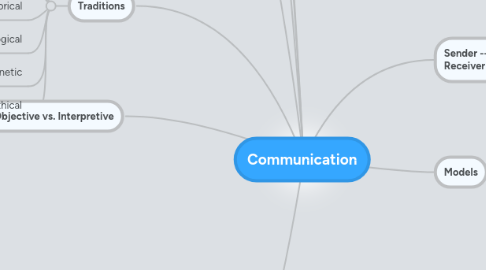
1. Objective vs. Interpretive
2. Traditions
2.1. Semiotic
2.2. Critical
2.3. Socio-cultural
2.4. Rhetorical
2.5. Socio-pschological
2.6. Cybernetic
2.7. Ethical
3. Interpersonal communication
3.1. Constructivism
3.2. Social Interactionism
3.3. Expectancy Violation
3.4. Social Penetration
3.4.1. Onion model
3.4.1.1. Breadth
3.4.1.2. Depth
3.5. Social Judgement Theory
3.5.1. Three zones
3.5.1.1. Latitude of Acceptance
3.5.1.2. Latitude of Rejection
3.5.1.3. Latitude of Non Commitment
3.5.1.4. �
3.6. Social Information Processing
3.6.1. Hyperpersonal Model
3.6.2. Warranting theory
3.6.3. Online communication theories
3.6.3.1. Social Presence
3.6.3.2. Media Richies
3.7. Uncertainty Reduction
3.7.1. Relational developments
3.8. Cognitive Dissonance
3.9. Relational Dialectics
3.9.1. Connectedness and Separateness
3.9.2. Certainty and Uncertainty
3.9.3. Openness and Closedness
3.10. Symbolic Convergence Theory
3.11. Functional Perspective on Group Decision-Making
3.12. Adaptive Structuration Theory
3.13. Media Ecology
3.14. Cultural Studies
3.15. Media Ecology
3.16. Cultural Studies
3.17. Cultivation Theory
3.18. Agenda Setting Theory
3.19. Spiral of Silence
3.20. Communication Accommodation Theory
3.21. Face Negotiation Theory
3.22. Genderlect Studies
3.23. Standpoint Theory
3.24. Muted Group Theory
3.25. Social Identity Theory
3.26. Feminist Standpoint Theory
4. Group and Public Communication
4.1. Organizational Communication
4.1.1. Gestalt Theory
4.1.2. Cultural Approach
4.1.2.1. Symbolic Interactionism
4.1.3. Corporate Culture
4.1.3.1. Chracter
4.1.3.2. Image
4.1.3.3. Climate
4.1.4. Stories
4.1.4.1. Corporate
4.1.4.2. Personal
4.1.4.3. Collegial
4.1.5. Critical Approach
4.1.6. Rhetorical Theory
4.1.6.1. Invention - discovery or convincing arguments
4.1.6.2. Arrangement - organization of materials for presentation for best impact
4.1.6.3. Style - the manner or language to be used
4.1.6.4. Delivery - the combination and coordination of all materials
4.1.6.5. Memory- mastery of content
4.1.7. Narrative Paradigm Theory
4.1.7.1. Social Judgment Theory
4.2. Public Rhetoric
5. Mass Communication
5.1. Theories
5.1.1. Media Ecology
5.1.2. Cultural Studies
5.1.3. Semiotic Theory
5.2. Media Effects
5.2.1. Cultivation Theory
5.2.2. Agenda-Setting Theory
5.2.3. Spiral of Silence Theory
6. Culture
6.1. High Context
6.2. Low Context Cultures
7. Intercultural Communication
7.1. Communication Accommodation Theory
7.1.1. Convergence
7.1.2. Divergence

